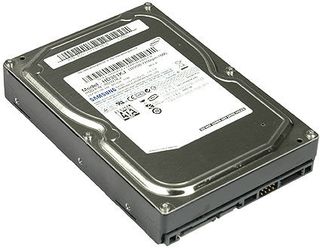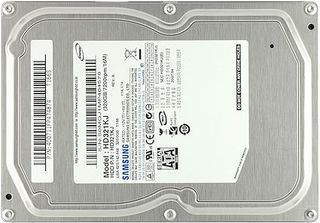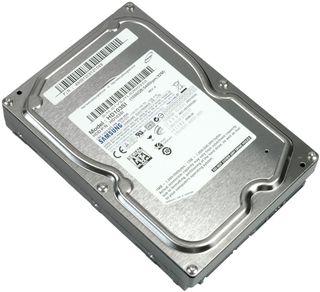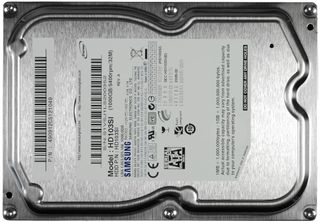Picking A Hard Drive For Your NAS: New Green Beats Old Speed
Drive Choice: Performance Or Eco? Spinpoint T166 Vs. F2EG

The Performance Option: Samsung Spinpoint T166 (HD321KJ)
We’ve been using Samsung’s Spinpoint T166 (HD321KJ) drives in our NAS tests for a while now. Originally, we picked this model because it offered high data transfer rates (for its time) while remaining affordable. Their capacity of only 320GB (definitely modest by current standards) actually works in our favor today, as it helps keep the time for some of our tests down. Besides, a higher capacity also means longer build times when initializing a RAID array. Believe us, waiting 24 hours for a terabyte of RAID storage to finish a build is about as much fun as watching the proverbial paint dry.

But let’s get back to the drive. Like all SATA/300 drives, Samsung’s HD321KJ supports both native command queuing (NCQ) and hot-swapping. It spins at 7,200 RPM and sports 16MB of cache as a buffer. To reach its nominal capacity, it employs two platters of 167GB each.
Peak data throughput comes in at 83 MB/s, although the hard disk performance benchmark h2benchw measured about 64 MB/s for both reads and writes. For reference, current 3.5” desktop drives can push about 120 MB/s. On the other hand, the RAID configurations found in most modern NAS servers are limited more by their processor than the hard drives, so even slower drives don’t usually become a bottleneck.
In the context of this comparison, the Spinpoint T166 is also a good reference point for users looking to upgrade an older NAS with newer drives. Aside from the obvious benefit of providing much more capacity, newer drives also tend to consume less energy.

The Eco Option: Samsung Spinpoint F2 EcoGreen (HD103SI)
Our other drives were also provided by Samsung. We opted for the Spinpoint F2 EcoGreen (HD103SI). Like the HD321KJ, this terabyte drive is built using two platters, each of which can store 500GB of data. Unlike the T166, the F2 EcoGreen is a current-generation drive, meaning that there are also some other notable differences.
Stay on the Cutting Edge
Join the experts who read Tom's Hardware for the inside track on enthusiast PC tech news — and have for over 25 years. We'll send breaking news and in-depth reviews of CPUs, GPUs, AI, maker hardware and more straight to your inbox.

Like its older sibling, Samsung’s HD103SI supports NCQ and uses the SATA/300 interface. However, the newer model sports 32MB of cache, twice as much as the T166.
At the same time, Samsung has dropped the spindle speed from 7,200 RPM to only 5,400 RPM in order to achieve the drive’s ambitions where low power consumption is concerned. Nonetheless, the drive achieves sequential read and write speeds of around 84 MB/s, while its maximum throughput comes in at over 100 MB/s. That’s not bad at all, considering the comparatively low spindle speed.
A Look at the Hard Drives
| Manufacturer | Samsung | Samsung |
|---|---|---|
| Model | Spinpoint T166 | Spinpoint F2 EcoGreen |
| Model Number | HD321KJ | HD103SI |
| Form Factor | 3.5" | 3.5" |
| Capacity | 320GB | 1,000GB |
| Rotation Speed | 7,200 RPM | 5,400 RPM |
| Other Capacities | 80, 160, 500GB | 500, 1500GB |
| Platters | 2 | 2 |
| Cache | 16MB | 32MB |
| Interface | SATA/300 | SATA/300 |
| Ambient Temperature | 0-60°C | 0-60°C |
| Power Consumption "Idle" (according to the manufacturer) | 7.6W | 4.6W |
| Shock Test (2 ms, read) | 63 G | 70 G |
| Warranty | 3 Years | 3 Years |
Current page: Drive Choice: Performance Or Eco? Spinpoint T166 Vs. F2EG
Prev Page The Test Bed: Synology DS409+ Next Page Pros And Cons Of Going Green?-
Is it a good comparison between 320 GB drives and 1 TB ones? Of course de 1 TB will perform better: much higher data density means less movement of heads and platters for the same amount of data. Gotta be faster. Nothing to do with the enclosure.Reply
Also I would like to mention from my own experience that heat can be a problem. I have a D-Link DNS323 and it cannot handle two server edition WD drives - it overheats.
- Bertus. -
evongugg If you buy a NAS, it's better to use the recommended drives, which have been put through hard tests.Reply
Other drives may experience RAID problems, burnout problems, etc.
If you want to salvage a NAS hard drive, you may be dealing with a Linux type partition.
-
Weird concept to compare an "old" performance drive with a new eco drive, where by default the new eco drive is outperforming the old performance drive in all categories.Reply
What is the expected result? Yes, we guessed right, the new eco drive is outperforming the old performance drive in a NAS environment.
Unfortunately that comparison does not allow any conclusion whether a NAS needs a performance drive or not, it only tells us that a new eco drive is better than an old performance drive.
Sad... -
awaken688 Totally agree with "theaxe" on this one. Not sure what this proved other than if you choice is an old performance drive vs. a new green one, choose the green one. Show me the WD 1TB Caviar Black vs. an equivalent "green" 1TB drive and then we can see more of a comparison that means something.Reply -
cknobman good thing we have the comments section so I dont wast my time reading a pointless article. first thought is "why in the f would you compare a 320gb to a 1gb?" reading the comments let me know my thought is right and not to waste time reading a pointless article.Reply -
chunkymonster ReplyOur comparison showed that the difference in write performance between faster and slower spinning hard drives is minimal to nonexistent when they are used in a NAS. Instead, the NAS’ RAID engine becomes the limiting factor.
Ok, I can understand the RAID engine being the limiting factor when using off the shelf NAS solutions, especially considering most off the shelf NAS solutions use software RAID. But, would a 5400RPM drive become the limiting factor, compared to a 7200RPM, when using a hardware RAID solution like an Areca, 3Ware, or HighPoint controller card? Any guesses? -
davidhbrown I've been reflexively buying 7200RPM drives for everything (notebooks, NAS, desktops) for so long now, that just the *concept* of the article is a useful reminder that in some settings, other issues might be important. Too bad the specific comparison may be flawed, but it's not like exactly that hardware is going to be relevant in six months anyway.Reply -
Even with a 10 watt difference, the electricity savings is negligible. At the nation average of 12 cents per kWh, using 10 less watts 24/7 for a year works out to be a whole $10.50. On the year. Less than $1 a month. A far cry from what the article stated: "the difference jumps into the two-figure range. And that can definitely make a difference when the time comes to pay your electric bill" I'll take that 88 cents I save a month and go buy...wait, what can you get for 88 cents these days?Reply
-
farrellj Just one thing...many consumer NAS boxes run a cut-down form of Linux...and Samba! And that makes it much more stable than some proprietary software that hasn't been as extensively tested as Linux/Samba has.Reply
Most Popular


